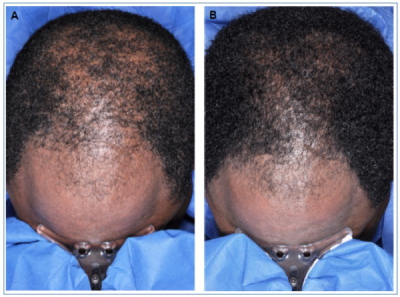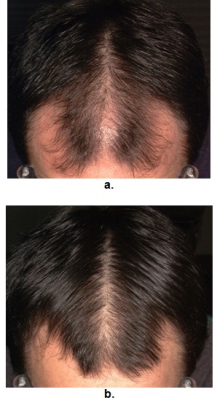I’m staring at the back of a generic minoxidil bottle right now. Guess what it says? That minoxidil only works on the crown, not on the hairline.
But many minoxidil users have reported significant frontal hairline gains.
Studies have noted similar improvements.
So, can minoxidil help you regrow your receding hairline?
The short answer is yes, but with some caveats, which I’ll address momentarily.
Before we go any further, let me introduce myself.
I’m Robert, your friendly neighborhood hair loss expert. In 2016, I launched the unbiased hair loss blog, Hair Loss Daily. And guess what? In 2021, I joined the balding club. That’s right. I’m in the same boat as you, my friend.
In this post, I’ll explain what you can expect if you’re using minoxidil as a receding hairline treatment. I’ll also provide you with some basic information about minoxidil, review the treatment’s potential side effects, and much more.
First, in case you’re unfamiliar with the world’s most popular hair loss treatment, let’s cover some basic facts about it.
What Is Minoxidil?
Minoxidil has been around for decades. I sometimes jokingly refer to it as “your grandpa’s hair loss remedy.”
Initially developed to treat hypertension, it was soon discovered that this medication had an intriguing side effect — hair growth.
Ever since its transformation into a hair loss treatment, minoxidil has become a staple in the battle against thinning hair and receding hairlines.
As a topical medication, minoxidil comes in various forms, from liquid solutions to foams, making it easy to incorporate into your daily routine.
How It Works
Simply, minoxidil stimulates hair growth.
It moves hair follicles from a resting phase to an active growth state.
Can Minoxidil Treat a Receding Hairline?
While early labeling on some minoxidil products claimed it was primarily for the crown, numerous real-life experiences and studies have debunked this myth. Many users have reported remarkable gains in their frontal hairline, showcasing the treatment’s efficacy beyond the crown area.
In 2015, the British Journal of Dermatology published a significant study. It focused on minoxidil’s impact on the crown and hairline. The results were promising, showing positive outcomes for both areas.

The appearance of this man’s receding hairline improved dramatically over the course of the study.
Another 2019 research review noted that minoxidil was highly effective at helping patients regrow hair that was thinning prior to treatment.
The “No Hair” Exception
Okay, now I have some bad news.
Minoxidil won’t regrow bald areas.
So, if you’ve lost your hairline completely, minoxidil isn’t going to help you.
But it may help regrow the hairs around the edges of the bald area, creating a more gradual transition between the bald and hairy parts of your scalp.
This could make your hair loss less noticeable. However, it’s important to have realistic expectations and understand that while minoxidil can work wonders for thinning areas, it can’t perform miracles on areas that are entirely bald.
How Effective Is Minoxidil?
A comprehensive observational study in 2012 shed light on minoxidil’s efficacy.
Nearly a thousand male pattern hair loss sufferers (984 to be exact) took part. They applied the 5% minoxidil solution twice daily. Every three months, hair strands lost during washing were counted in a lab. Dermatologists assessed each participant’s hair loss at the study’s commencement and conclusion. The findings revealed:
- Hair loss areas shrank for 62% of participants, remained unchanged for 35.1%, and expanded for only 2.9%.
- The 5% minoxidil solution was classified as very effective for 15.9% of users, effective for 47.8%, moderately effective for 20.6%, and ineffective for 15.7%, resulting in a success rate of around 84%.
- The mean number of hairs shed during washing dropped from 69.7 at the study’s outset to 33.8 at its culmination.
Minoxidil’s Side Effects
For most individuals, minoxidil doesn’t cause any major issues.
The common side effects are skin-related: irritation, redness, dryness, flaking, and scalp inflammation.
In that 2012 study involving 984 participants, only 3.9% reported these effects, and none were considered severe by the researchers.
Absorption and Its Consequences
If minoxidil enters your bloodstream, the side effects may become more serious. Absorptive side effects of minoxidil may include dizziness, chest discomfort, swelling in extremities, fainting, breathing difficulties, low blood pressure, and even gastrointestinal issues. A small percentage of patients have also reported irregular heartbeats and similar concerns.
Fortunately, there’s a silver lining. According to the American Hair Loss Association, the small amounts of minoxidil typically absorbed into the bloodstream rarely triggers significant internal disturbances.
When Will You Start to See Results?
Most users who respond favorably to the treatment report improvements within four to six months. Your success will be dependent on a variety of factors, including the extent of your hair loss, your expectations, and how well you comply with the treatment guidelines.
However, your hair may appear a little thinner before it thickens. Don’t worry. This stage in the treatment process is normal and temporary. It’s commonly referred to as the “dread shed.” During the dread shed, thinning hairs are simply being replaced with thicker, healthier ones.
Minoxidil Alternatives
If you’re seeking alternatives to minoxidil for treating your receding hairline, several options warrant consideration. Here are a few:
1. Finasteride: Finasteride, an oral medication, is indisputably the most effective hair loss treatment option for men. With an efficacy rate of approximately 90 percent, it surpasses minoxidil in effectiveness. Finasteride works by inhibiting the production of dihydrotestosterone (DHT), the hormone that effectively causes pattern hair loss. Studies have shown that finasteride not only slows hair loss but also prompts regrowth in many cases.

Before-after results from one of Propecia’s clinical trials.
However, like any medication, finasteride comes with potential side effects. These may include sexual dysfunction and, in rare cases, depression. Before initiating finasteride treatment, consulting a healthcare professional is crucial to weigh its benefits against possible risks.
2. Laser Therapy: Low-level laser therapy (LLLT) involves leveraging red light to stimulate hair follicles and encourage hair growth. Although the precise mechanisms are not entirely clear, some studies have indicated positive outcomes in terms of hair regrowth and increased hair density. Laser therapy is available in various forms, such as laser combs, helmets, and caps.
3. Supplements: Certain nutritional supplements, like saw palmetto, pumpkin seed oil, and marine collagen, are marketed as aids for hair growth. While scientific evidence supporting their efficacy is limited, they might still complement a comprehensive hair care routine. It’s advisable to consult a healthcare professional before incorporating supplements.
4. Female Hair Loss Treatments: For women grappling with thinning or receding hairlines, hormonal factors often play a pivotal role. Birth control pills containing both estrogen and progestin could help regulate hormonal imbalances contributing to hair loss. It’s essential to consult a healthcare provider before embarking on any hormonal treatments, as these can have diverse effects on the body. This article on female hair loss contains more information on the various treatments and products available to women.
Does Minoxidil Work on a Receding Hairline? Closing Thoughts
Robert Price is a writer, consumer advocate, and hair loss researcher with thousands of hours of experience in the field. His goal is to keep you out of the hair loss rabbit hole, underworld, or whatever you want to call it. He founded Hair Loss Daily, the unbiased hair loss blog, in 2016. You can learn more about Robert in the my story section of this website.


